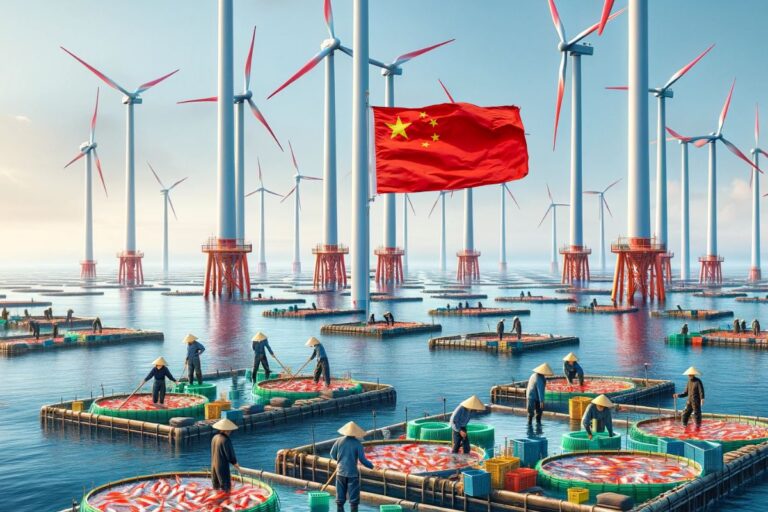In an exciting leap forward for renewable energy, China has just unveiled the world’s most powerful wind turbine, marking a significant milestone in the country’s efforts to transform its energy landscape. This breakthrough could have far-reaching implications for the future of global energy production and consumption.
A New Era for Renewable Energy
On June 5th, China’s Dongfang Electric Corporation, a state-owned enterprise known for manufacturing power generators, successfully installed an 18 MW wind turbine at a coastal test site in Guangdong province. This installation is not just a technical achievement—it represents China’s growing commitment to moving away from fossil fuels and investing in cleaner, sustainable energy sources.
This enormous turbine stands out not only for its size but also for its potential to revolutionize energy production. With wind power playing an increasingly crucial role in addressing climate change, China’s leadership in this sector is becoming more evident.
Impressive Dimensions and Capabilities
At the heart of this wind turbine’s innovation is its sheer scale. The rotor has a diameter of 260 meters, covering an area larger than 53,000 square meters—that’s over seven football fields. With such vast dimensions, the turbine is capable of generating 72 million kWh per year, enough to power 36,000 households. What’s more, this technology will help reduce China’s reliance on coal, cutting back 22,000 tons of coal consumption and preventing the emission of 59,000 tons of CO2 annually. These numbers are not just impressive—they highlight the profound environmental impact of this technology.
As the world grapples with the urgent need to curb emissions, developments like this provide a promising glimpse into a future where energy production is cleaner and more sustainable.
The Race for Bigger Turbines
China isn’t alone in this race to develop ever-larger turbines. Companies like MingYang Smart Energy are also working on 18 MW turbines, with the potential to reach up to 20 MW under optimal conditions. This competition to create the world’s largest and most powerful wind turbines signals a broader shift in China’s strategy. Unlike some Western manufacturers, such as Vestas or GE Electric, who have recently scaled back their ambitions in the large turbine market, China continues to push the envelope on innovation.
This pursuit of larger turbines reflects China’s broader strategy to dominate the renewable energy sector. As the country invests heavily in technology and research, it is positioning itself as a global leader in wind power. This could have significant implications not just for the domestic market but for international markets as well, as China increasingly exports its cutting-edge technology.
China’s Technological Superiority in Wind Energy
While Western companies are taking a cautious approach, China is moving forward with bold innovations in wind energy technology. This difference in approach underscores China’s growing dominance in the renewable energy field. The nation’s continued investment in research and development, along with its government-backed initiatives, is setting the stage for the country to lead in the global energy transition.
China’s success in wind energy isn’t just a matter of building larger turbines; it’s also about mastering the technology and scaling it up for widespread use. The country’s ambitious projects aim to harness the power of wind like never before, positioning it to meet its own energy needs while also becoming a major exporter of renewable energy technologies.
Environmental and Economic Impacts
The environmental implications of this wind turbine installation are clear: it offers a greener, more sustainable alternative to traditional fossil fuels, helping to reduce air pollution and carbon emissions. On a larger scale, the integration of such turbines could significantly contribute to reducing the global reliance on coal, oil, and gas.
Beyond environmental benefits, these innovations also have the potential to drive economic growth. By developing advanced renewable energy technology, China is not only addressing its domestic energy needs but also opening up new markets for exports and creating thousands of jobs in the green energy sector.
Overcoming Challenges in Energy Innovation
Despite the excitement surrounding China’s progress in wind energy, there are still significant challenges ahead. Integrating these massive turbines into existing energy infrastructure will require substantial investment and upgrades to national grids. There are also regulatory hurdles to navigate, especially as the technology evolves and becomes more widespread.
Moreover, the social acceptance of large renewable energy projects is an ongoing issue. Communities and local governments must be on board with the shift to green energy, which will require educational efforts and careful planning to address concerns and potential resistance.
Looking Ahead: A Clean Energy Future
The unveiling of China’s 18 MW wind turbine is a defining moment in the world’s push toward renewable energy. This massive leap in technology not only highlights China’s growing dominance in the sector but also signals a potential turning point in the global energy transition. As wind turbines become increasingly powerful and efficient, they offer a viable alternative to fossil fuels, helping to combat climate change and reduce environmental harm.
While challenges remain, China’s commitment to innovation in renewable energy is clear. With this new turbine as a starting point, the country is poised to lead the charge toward a cleaner, more sustainable future, both for itself and for the world. As we continue to confront the pressing challenges of climate change, advancements like this remind us that technology has the power to reshape our future for the better.






